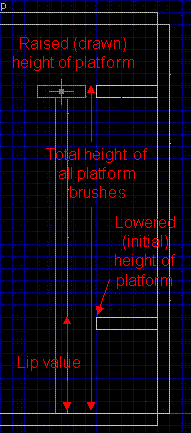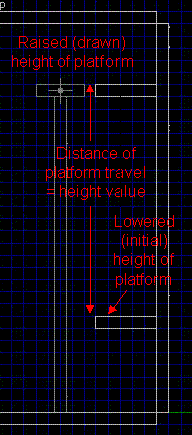Func_plat
written by EutecTic
1. Introduction to Quake 2 platforms
Platforms in Quake 2 work pretty
much the same as in Quake 1 with a few minor distinctions. Let's first
take a look at what is unchanged and clarify a few things at the same time:
-
Platforms can only be made to go up.
IOW, their normal idle position is the lowered position unless
they are targeted (more on this later).
-
Plats must be drawn in the raised
position in the map editor so the lighting can be calculated properly by
the compiling utility (Qrad3).
-
BUT, a platform will initially
be drawn in the lowered position in the game unless it is targeted.
Now, let's take a look at what has changed
from Quake 1 to Quake 2 about platforms. Unfortunately, these differences
are not really an improvement. IMO, it's quite the opposite, here's why:
-
In Quake 1, when you wanted a plat to
start in the raised position, you simply set the "Plat Low Trigger"
spawnflag (who knows why they called it that?). Once the plat was touched
or triggered and brought down the first time, it would thereafter function
like a normal platform.
-
In Quake 2, if you want the platform
to start in the raised position, you have to target it with a trigger,
independently of the state of the "Plat Low Trigger" spawnflag. If you
set the spawnflag without targeting the plat, nothing will happen
and it will just behave as a normal plat. IOW, the spawnflag is
useless by itself. This is the first setback compared to Quake 1.
-
For platforms in Quake 1, you had 2 choices
of sounds or no sound at all if you wanted them to be silent.
-
In Quake 2, platforms not only don't
have any choice of sounds, but you can't even make them silent
either. This is what I call "major setback No. 2" in platforms. Funny,
I somehow expected more from Quake 2 plats than Quake 1 plats, not less!...
Oh well...
2. Ok, how do I make these work? Do I use height and lip?
There are 2 basic ways to make and
set platforms to operate exactly the way you want (that is within their
basic limitations):
The first and most common way is to
use the physical dimension of the brushes that are part of the platform
to set it's up-down travel distance. In this particular case, the height
key pair is not used but the lip key pair is and can be extremely
useful. The basic setup formula in this case is as follows:
(Total platform height - lip
value) = platform travel distance
Total platform height:
This is the overall height
of all the brushes that are part of the func_plat entity when measured
from the lowest point to the highest point. You're probably
thinking: hey! This definition is overkill. I could have figured that out
for myself long ago! All I have to do is add up all the individual heights
of all the brushes that are part of my plat and I'm in business right?...
Well, as long as none of your brushes overlap heightwise.
Otherwise, you'll have to measure the distance from the highest
to the lowest point.
Lip value:
The height or amount by which your
platform will be raised from the floor when it's in the lowered
position.

Figure 1: First method of evaluating platform travel
The second and easiest, most predictable
way to set your platforms is to use the height key pair. In this
case, the physical dimensions of the brushes that are part of the
platform have no importance and the lip key pair has no
effect and needs not be used. The basic setup formula is as simple
as it gets:
height value = platform travel
distance
I bet you're saying: what?... that's
it?... Yep! That's it! That's all there is to it. Just make the
platform and turn it into a func_plat. Measure the distance
between the start and end position of the top of your
platform and transfer that value straight to the height key pair
and you're all set. It makes no difference what size or shape
the brushes of your platform are or whether they overlap or not
when using this method. The only restriction is that the plat has to be
drawn in the raised position as always.

Figure 2: Second method of evaluating platform travel
So in conclusion, both methods work fine. Choosing which one to use at this point depends mainly on design particulars and personal taste.
You can also specify the speed,
acceleration and deceleration
of the platform. Speed, acceleration and decelaration are self explanatory. If
you want to have the platform triggered then just give it a targetname
and target it with a trigger.
I have put an example of func_plat
in the example map. So if you are having any problems
then be sure to check it out. Any other questions please post
to the discussion board.
Return
to Tutorials Page...
|
